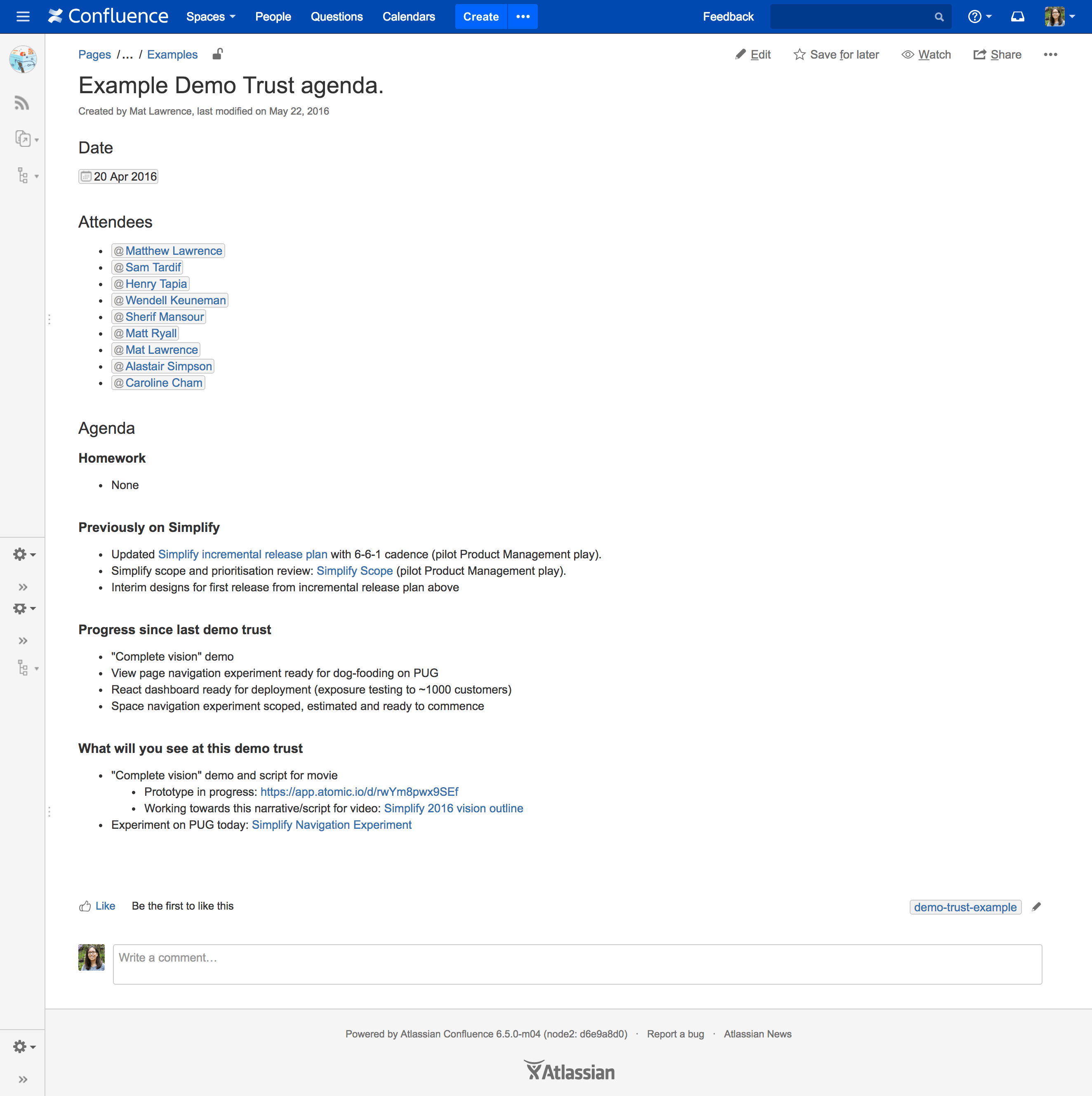Demo Trust
When project and leadership teams see eye to eye early on, it helps everyone feel confident the work being done is valuable to the customer and fits into a broader strategy.
USE THIS PLAY TO...
Create a safe space for open discussion and honest project feedback.
Help leadership teams scale themselves across projects by providing guidance when it has the biggest impact.
If you're struggling with , or on your Health Monitor, running this play might help.

People
4 - 6

Prep Time
30 min

Time
60 min

Difficulty
Moderate
Running the play
Don't waste your leadership team's time by using the demo trust to ask open-ended questions about direction. Present your best idea, and give them an opportunity to challenge it. Be sure to send them an agenda and any background material a day in advance.
Materials
Laptop
Large display screen
Whiteboard
Prep
Do your homework (30 min)
Project team
Schedule a 1-hour session and confirm everyone can be there the full hour. Keep the agenda concise, with the most important items to discuss first on the list. Be clear about the type of feedback you're looking for so the session doesn't run away from you.
Link or embed any personas, journey maps, sketches, prototypes, etc. to the agenda page. But don't overwhelm the leadership team with every last detail. If using a project poster, make sure it's up to date – remember: it should be your single source of truth!
Don't waste time creating a slide deck for demo trusts. The mock-ups, sketches, journey maps, prototypes, project poster, etc. your team are using day-to-day are enough. Keep it scrappy and authentic.
Leadership team
Read the agenda in advance, and review any linked material you're not already familiar with. Note any specific questions or concerns you'll want to cover in the session.

For example...
To the surprise of nobody, we use Confluence to spell out the agenda.
Step 1
Set the stage (5 min)
Be clear about where you're at in the project's lifecycle. Exploring a new concept? Iterating based on something new you've learnt while executing the project?
Review the agenda, and be open to adjusting it. Are there any items missing or items that should be higher priority? Don't be afraid to remove an item from the agenda if everyone in the room already feels comfortable with that facet of the project!
Step 2
Demo, discuss, decide (50 min)
Project team
Demo what you're envisioning or already executing on. This could be a strategy, a product feature, or a new program – anything consumable by internal or external customers. The main purpose of this session is to show (yes: actually, physically show using prototypes, journey maps, etc.) what you're aiming to create, so resist the temptation to talk through heaps of information. After you've shared the big picture and the end-to-end journey, demonstrate how you will break that down into incremental deliverables that provide value to the customer.
Be sure to demonstrate your understanding of why it's important to the business and/or valuable to the customer, too. What's the benefit? What trade-offs are you making? How will the customer's experience be affected?
Leadership team
Question and challenge the demo whilst providing just enough guidance and feedback to keep the project heading in the right direction. Does the project align with broader strategies? Is the concept clear and straightforward?
Also look out for overlap with other teams and projects. Are there teams or people who should be kept informed? Places where separate project teams can link up to kill two birds with one stone? Areas where two project teams may be duplicating efforts?
Full group
Decide on any high-level course corrections based on the discussion. Don't get way into the details, though – save that for sparring or deeper discussions amongst the project team.

Anti-pattern
You demo nearly-complete work or a high-fidelity prototype.
This is a sign you should've run the demo trust play sooner. Still, run it – "better late than never". But know that incorporating the leadership panel's feedback on your project may involve major re-work that results in a longer timeline or reduced scope for the project.
Step 3
Take a confidence vote (5 min)
Everyone rates their confidence in the project based on the work shared and decisions made. A scale of 1 - 4 works well because it forces people to express an actual opinion instead of copping out with a square-in-the-middle rating.
If there's time, have each person briefly explain their rating so the project team have a better understanding of what they've nailed and what they need to work on.
Wrap it up
Capture any follow-up items on the agenda page or project poster. Optionally, schedule another session 2 - 4 weeks out, depending on the scope of the project.
When to stop running the demo trust
Hold sessions periodically until you're ready to execute on whatever you've demoed. If the group's confidence level is high after the first session, you may not need more.
You'll know you're ready to execute when...
- The project poster is complete and the leadership panel agree with it's content.
- The end-to-end journey is agreed upon and broken down into deliverable increments.
- Demo trust participants are confident in the customer experience and how it fits with the bigger picture.
- Success criteria is agreed upon.
If these elements are missing, ask what else you need to know or do in order to gain confidence. Is something missing? Should an experiment be run? More user research?
When all these elements are in place, move into execution mode and run the sparring play with your project team as needed. If your project involves a lot of risk or uncertainty, consider keeping the demo trust alive so your leadership team can continue to guide you as new $#!τ comes to light.
Wrap it up
Capture any follow-up items on the agenda page or project poster. Optionally, schedule another session 2 - 4 weeks out, depending on the scope of the project.
Nailed it?
Be sure to run a full Health Monitor session or checkpoint with your team to see if you're improving.
Follow-ups
Keep your question "chain" handy. It's good food for thought, and good for sense-checking progress in the project. E.g., half-way into the project, are you still solving the problem that you agreed upon?
Transfer the problem to an experience canvas or project poster, if you're working on one. Write the problem you're tackling in the 'Problem' section, and use that to help you build out the rest of the canvas or poster.
Want even more Playbook?
Drop your email below to be notified when we add new Health Monitors and plays.
Got feedback?
Drop a question or comment on the Atlassian Community site.
